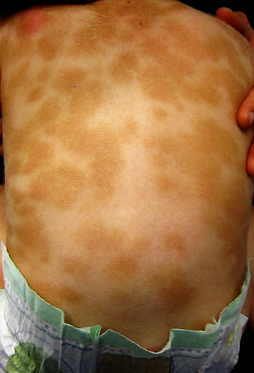Mastocytosis and mast cell disorders
Peer reviewed by Dr John Cox, MRCGPLast updated by Dr Laurence KnottLast updated 9 Jul 2017
Meets Patient’s editorial guidelines
- DownloadDownload
- Share
- Language
- Discussion
This page has been archived.
It has not been reviewed recently and is not up to date. External links and references may no longer work.
A mast cell is a type of white blood cell. There are several forms of mastocytosis. In one, there are too many mast cells in the body: in another the number of mast cells is normal but they are too active.
In this article:
Continue reading below
What are mast cells?
Mast cells are a type of white blood cell - together, our white blood cells play a major role in our immune system, helping us fight off infection and other invaders. Mast cells are packed with histamine, a chemical released when you have an allergic reaction. They also contain heparin, a chemical which stops the blood from clotting. Mast cells are hard-working cells that have many functions, including helping to fight infection and healing wounds.
However, mast cell disorders can occur in which too many cells are produced or they become overactive.
What are the types of mast cell disorder?
Mastocytosis
This is the term used when too many mast cells are produced. There are many different types of mastocytosis. The most common types are:
Those involving the skin (cutaneous).
Those which involve lots of different tissues of the body (systemic).
Much less commonly there is a localised type in which clumps of mast cells gather in one place.
Mast cell activation syndrome
You may also see mast cell activation syndrome (MCAS) called mast cell activation disorder (MCAD). The mast cells are present in normal numbers but they are triggered to release their chemicals more readily than usual. The symptoms are generally the same as mastocytosis.
Localised mast cell disorder
Rarely, clumps of mast cells can develop in one area of the body.
Continue reading below
What causes mast cell disorders?
The cause is not known. It is suspected that there is a fault in the gene (the material inherited from your parents) that controls mast cell production.
Triggers for mastocytosis symptoms
Although not strictly speaking the cause of mastocytosis, a number of factors are known to trigger the symptoms. These include:
Physical triggers - for example, heat, cold, rubbing, sunlight, tiredness, lots of exercise, a high temperature (fever).
Emotional triggers - for example, stress.
Some foods - for example, cheese, spices, shellfish, food preservatives, flavourings and colourings, monosodium glutamate.
Toxic substances in the environment - for example, perfumes, pesticides.
Insect bites, jelly fish stings, snake bites.
Infection with germs (bacteria), funguses or viruses.
Alcohol.
Medicines - for example, anaesthetic agents, aspirin, antibiotics, opioids and many other medications.
Who gets a mast cell disorder?
These conditions are not very common. Altogether, they occur in about 1 in 150,000 people. The most common type - urticaria pigmentosa (see section on symptoms, below) - is seen in 1 person in every 1,000 who attends a skin (dermatology) clinic.
Continue reading below
What are the symptoms of mast cell disorders?
Cutaneous mastocytosis
When larger than normal numbers of mast cells are present in the skin they commonly cause a condition called urticaria pigmentosa. Another less common condition called diffuse cutaneous mastocytosis is also sometimes seen.
Urticaria pigmentosa
Urticaria Pigmentosa

By James Heilman, MD (Own work) CC BY-SA 3.0, via Wikimedia Commons
This usually starts in babies a few months old but can go on for years. It causes a rash to appear anywhere on the body, made of light brown, itchy raised patches.
If you rub the patches, they become red and swollen and blisters develop. This is called Darier's sign.
Rarely, after rubbing or applying heat to the skin, a severe allergic effect (an anaphylactic reaction) can occur .
Your child may develop dermographism - this is a condition in which you can 'write' on the skin with a blunt object.
The condition usually gets better as your child becomes older and it usually disappears by the time they reach their teens. Rarely, an adult form can develop.
Diffuse cutaneous mastocytosis
This usually occurs in children less than 1 year old.
They develop a very itchy rash with yellow, thickened skin.
Large blisters can appear for no reason or after a very light amount of rubbing.
If large areas of skin are involved, bodily symptoms can develop such as flushing, headache and the sensation of having a 'thumping' heart (palpitations). Tummy pains, diarrhoea and breathlessness can occur., The child can go into shock and become very ill. Some children have died of this condition.
Localised mastocytosis
Rarely, clumps of mast cells can form a nodule in the skin, which is usually red, brown or yellow in colour. This is called a mastocytoma. Even more rarely, a cancerous (malignant) lump called a mast cell sarcoma can develop.
Systemic mastocytosis
This can cause a whole range of symptoms depending on the parts of the body where large numbers of mast cells are found. For example:
Skin - flushing of the face, urticaria pigmentosa (see above).
Digestive system - tummy pains, diarrhoea, pale stools that are difficult to flush, feeling sick (nausea) or being sick (vomiting), acid indigestion, stomach ulcers.
Swelling of the liver or spleen.
Circulatory problems - fainting, low blood pressure, anaphylactic shock.
Anaemia; other problems with the blood or bone marrow.
Fractures of the bones (because of bone marrow involvement).
Swollen lymph nodes.
Breathing difficulties.
Headaches, pins and needles, numbness.
How are these conditions diagnosed?
It's usually possible to guess the diagnosis if the skin is involved. However, the more generalised form causes so many different symptoms it may only become clear what the problem is once tests have been done.
What else could it be?
Because there can be so many different symptoms, the disorders can easily be confused with other conditions. These can include other skin disorders, liver and bowel problems, glandular conditions and rare tumours.
Will I need any tests?
You will need a sample taken from your skin (a biopsy) for genetic testing. Chest and bone X-rays or scans may be needed. Various blood and urine tests will be arranged. The main test involves removing some bone marrow or tissue from an area other than the skin. The sample is tested for the presence of mast cells: various genetic and chemical tests may also be performed.
How are mastocytosis and other mast cell disorders treated?
There is no treatment that will actually cure these conditions but a wide variety of medicines is available to control the symptoms.
Acute anaphylaxis
If you are prone to sudden severe allergy symptoms you should avoid trigger factors. It's a good idea to wear a medical emergency identification bracelet or similar. If you've been given treatment advice from a specialist about what to do during an attack, carry it with you. Acute severe reactions are usually treated with adrenaline (epinephrine) injections, anti-allergy medication, fluids into a vein and steroids. You might need to carry an adrenaline (epinephrine) pen injector with you which can be obtained from your doctor. Some people need a course of injections to reduce their sensitivity to insect stings.
Skin and symptoms related to blood circulation
Itching, flushing and other skin allergy symptoms can be controlled by medicines called H1-receptor and H2-receptor antagonists. These include chlorphenamine, ketotifen and cimetidine.
Medication which stabilises the mast cells such as sodium cromoglicate, nedocromil and ketotifen.
Steroid creams or ointments and injections are sometimes used.
Treatment also used for psoriasis - called psoralen combined with ultraviolet A (PUVA) treatment - sometimes helps.
Wheezing
Inhalers to relax the airways - for example, salbutamol - can be helpful.
Digestive symptoms
H2-receptor antagonists or proton pump inhibitors help to control the effects of excess acid.
Oral sodium cromoglicate is beneficial in people with diarrhoea and tummy (abdominal) pain.
Anticholinergic medication such as propantheline (which blocks the effects of a body chemical called acetylcholine) may help control diarrhoea.
Other treatments
Medicines called leukotriene inhibitors used mainly in asthma - for example, montelukast - have been used. Low-dose aspirin and steroid tablets have been found helpful to control many different symptoms.
If the condition is severe, surgery to remove the spleen (splenectomy), medicines that have an effect on the immune system (such as interferon), bone marrow transplant or stem cell therapy may be considered.
Editor’s note
Dr Sarah Jarvis, 28th September 2021
Midostaurin for treating advanced systemic mastocytosis
The National Institute for Health and Care Excellence (NICE) has brought out new guidance on the use of midostaurin for people with mastocytosis.
Midostaurin targets and inhibits an enzyme called tyrosine kinases on the surface of the cell. This means it can help block the number of mast cells expanding. It is sometimes used as a treatment for certain types of the blood cancer called acute myeloid leukaemia.
NICE recommends that midostaurin is recommended as an option for people with severe forms of mastocytosis:
Aggressive systemic mastocytosis.
Systemic mastocytosis linked to blood cancer.
Mast cell leukaemia in adults.
You can find out more about NICE's recommendations from the further reading section below.
What is the outlook for these conditions?
Cutaneous mastocytosis in children often settles down with time. Adults can go on to develop the systemic form.
Systemic mastocytosis tends to be persistent and the outlook (prognosis) depends on which parts of the body are involved. In most cases, it just keeps going at a low level for decades, requiring treatment to control symptoms. Occasionally, however, it can become aggressive and even life-threatening.
Most cases of localised mastocytosis cause lumps that are nothing to worry about but occasionally cancers do occur which invade the surrounding tissue.
Patient picks for Autoimmune problems

Allergies, blood and immune system
Localised scleroderma
Localised scleroderma causes one or more patches of hard skin. There are different types. The common plaque type usually causes no problems (apart from sometimes an unsightly appearance) and tends to fade in time. The linear type can cause problems to underlying tissues such as muscles and bones. Often no treatment is needed for the plaque type but treatment may be advised in more severe cases and for the linear type.
by Dr Colin Tidy, MRCGP

Allergies, blood and immune system
Behçet's disease
Behçet's disease (also known as Behçet's syndrome) is a rare condition which causes frequent ulcers in your mouth and genital area and can affect different parts of your body. It most commonly affects your eyes and skin. It is more common in people from Mediterranean countries and also those from the Middle East and Eastern Asia. Various treatments are available which help reduce long-term complications.
by Dr Rosalyn Adleman, MRCGP
Further reading and references
- Cardet JC, Akin C, Lee MJ; Mastocytosis: update on pharmacotherapy and future directions. Expert Opin Pharmacother. 2013 Oct;14(15):2033-45. doi: 10.1517/14656566.2013.824424.
- Maculopapular cutaneous mastocytosis; DermNet NZ, 2014
- Pardanani A; Systemic mastocytosis in adults: 2017 update on diagnosis, risk stratification and management. Am J Hematol. 2016 Nov;91(11):1146-1159. doi: 10.1002/ajh.24553.
- Midostaurin for treating advanced systemic mastocytosis; NICE Technology appraisal guidance, September 2021
Continue reading below
Article history
The information on this page is written and peer reviewed by qualified clinicians.
9 Jul 2017 | Latest version

Ask, share, connect.
Browse discussions, ask questions, and share experiences across hundreds of health topics.

Feeling unwell?
Assess your symptoms online for free
Sign up to the Patient newsletter
Your weekly dose of clear, trustworthy health advice - written to help you feel informed, confident and in control.
By subscribing you accept our Privacy Policy. You can unsubscribe at any time. We never sell your data.